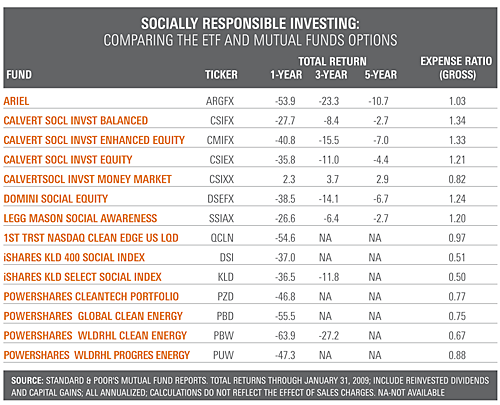Socially Responsible Investing How Do Socially Responsible Investments Perform
Post on: 6 Май, 2015 No Comment

- Fotosearch/ Getty Images
Socially responsible investing has sometimes been seen as the practice for people who are interested in social change first and a healthy return on their investment second. Certainly there was a time when it was difficult to create an SRI portfolio that was competitive with a traditional portfolio, simply because the universe of SRI options wasn’t particularly large.
But times have changed. Today there are more than 200 mutual funds that include social screens in their management decisions. Investors can create a portfolio that is competitive and true to their social concerns. There are also greater opportunities for more direct investment, such as purchasing certificates of deposit with community banks. For investors with more gumption and capital, there are riskier vehicles such as SRI venture funds.
But let’s stick with common stocks for now. SRI advocates can build a case that this form of investing is very competitive to mainstream investing. Perhaps the most cited source is the Domini 400 Social Index. which is a market cap weighted stock index of 400 public companies that meet varying social and environmental criteria.
The Domini 400, also known as the DS400, is managed by KLD Research and Analytics. It is made up of 250 S&P 500 companies; 100 non-S&P 500 companies that are selected because of their market capitalization and the various sectors they represent; and 50 other companies that have “exemplary” social and environmental records, according to KLD.
The DS400 provides a good sample of long-term SRI performance, having been created in 1990. Since then its average annual return has been 11.01 percent. Meanwhile the S&P 500, the baseline index that smaller indexes are compared to, had an average annual return of 10.57 percent.
Not Better, But As Good
Does that mean SRI investors outperformed those who spread their funds more broadly since 1990? Not at all. Besides the obvious fact that not all SRI practitioners owned all the stocks in the Domini 400, there were periods since 1990 when the DS400 lagged the S&P. So even if one owned all of those stocks, the date of purchase would be significant.
The performance of the DS400 shows that as a broad concept, socially responsible investing has the potential to provide good returns. Of course the same might be said for people who follow a strategy of investing only in children’s retailers or media companies. The point is that SRI is a viable, competitive approach.
Some SRI strategies have performed spectacularly over periods of time. Consider the clean energy sector, a segment of the economy that is certainly attractive to socially responsible investors. Clean energy is a sector that “promotes environmental sustainability by reducing pollution, curbing greenhouse gas emissions, improving domestic energy security, and improving efficiency,” according to Richard Asplund, equity research director at Melvin & Company, a Chicago-based institutional brokerage firm.
Melvin & Company’s Clean Energy Stock Index. made up of 62 publicly-traded clean energy companies, reported an average annual gain of 31.9 percent from 2002 through 2007, exceeding the S&P 500 by an average of 26.5 percentage points per year. It also exceeded the Russell 2000, an index of smaller growth stocks, by an average of 22.2 percentage points per year,
Socially responsible advocates could point to that index as proof that an SRI approach outperforms conventional investing. But Asplund points out that through the first third of 2008, clean energy stocks fell sharply along with the broad market correction and a shake-out of excessive speculation in the sector.
More SRI Benchmarks
Increasingly new indices are being created that enable investors to compare SRI to more broad based investing. The Cleantech Index was added to the American Stock Exchange in 2006 and tracks the performance of 46 leading publicly traded companies in 11 sectors such as alternative energy, energy efficiency, environmental quality and transportation. In 2007 the Cleantech Index was up 42.9 percent, compared to 10.6 percent for the NASDAQ Composite Index and 5.5 percent for the S&P 500.
Since 1999 the Dow Jones Sustainability Indexes have been tracking the financial performances of the leading “sustainability-driven” companies. The group includes global, European, Eurozone, North American and US benchmarks. Sustainable investing is essentially the same as SRI, though SI investors place more emphasis on environmental issues in their stock screens.














